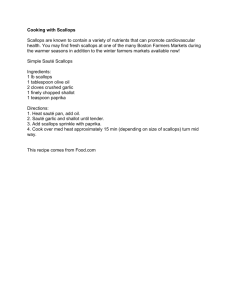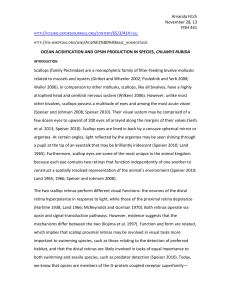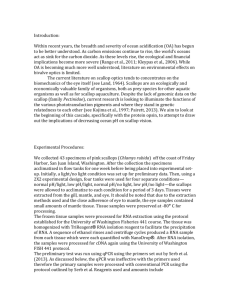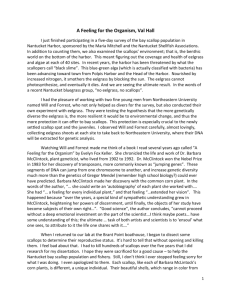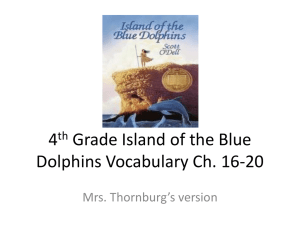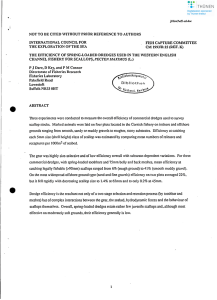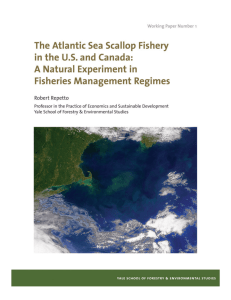View Article - Eastern Fisheries Inc
advertisement
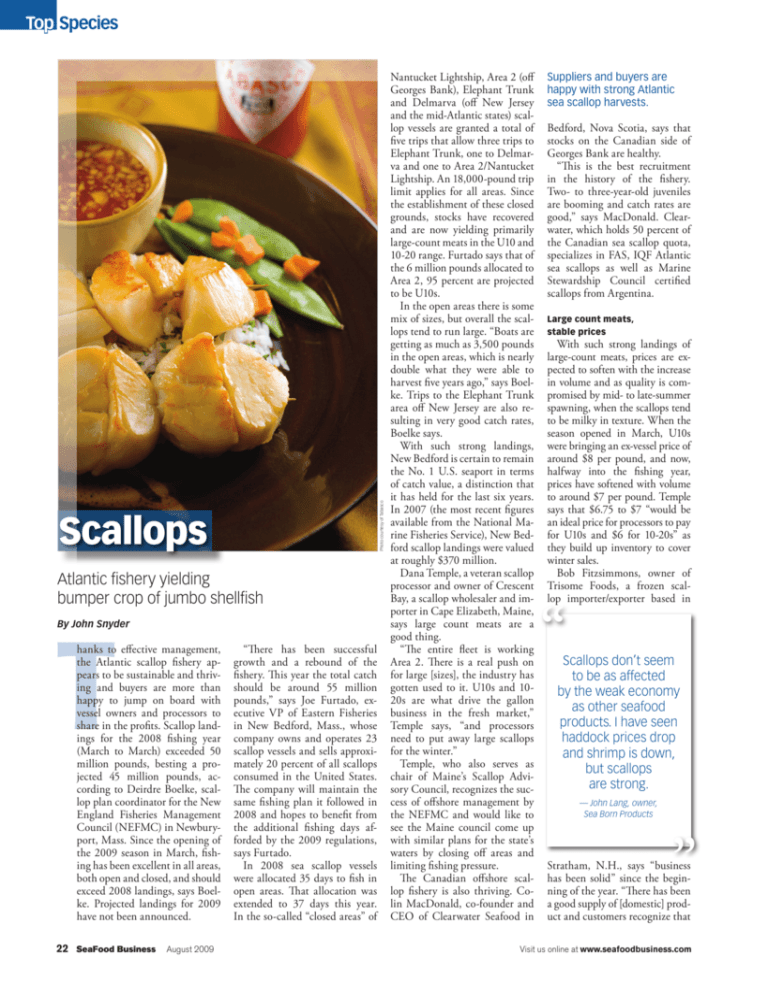
Photo courtesy of Tabasco Top Species Scallops Atlantic fishery yielding bumper crop of jumbo shellfish T By John Snyder hanks to effective management, the Atlantic scallop fishery appears to be sustainable and thriving and buyers are more than happy to jump on board with vessel owners and processors to share in the profits. Scallop landings for the 2008 fishing year (March to March) exceeded 50 million pounds, besting a projected 45 million pounds, according to Deirdre Boelke, scallop plan coordinator for the New England Fisheries Management Council (NEFMC) in Newburyport, Mass. Since the opening of the 2009 season in March, fishing has been excellent in all areas, both open and closed, and should exceed 2008 landings, says Boelke. Projected landings for 2009 have not been announced. 22 SeaFood Business August 2009 “There has been successful growth and a rebound of the fishery. This year the total catch should be around 55 million pounds,” says Joe Furtado, executive VP of Eastern Fisheries in New Bedford, Mass., whose company owns and operates 23 scallop vessels and sells approximately 20 percent of all scallops consumed in the United States. The company will maintain the same fishing plan it followed in 2008 and hopes to benefit from the additional fishing days afforded by the 2009 regulations, says Furtado. In 2008 sea scallop vessels were allocated 35 days to fish in open areas. That allocation was extended to 37 days this year. In the so-called “closed areas” of Nantucket Lightship, Area 2 (off Georges Bank), Elephant Trunk and Delmarva (off New Jersey and the mid-Atlantic states) scallop vessels are granted a total of five trips that allow three trips to Elephant Trunk, one to Delmarva and one to Area 2/Nantucket Lightship. An 18,000-pound trip limit applies for all areas. Since the establishment of these closed grounds, stocks have recovered and are now yielding primarily large-count meats in the U10 and 10-20 range. Furtado says that of the 6 million pounds allocated to Area 2, 95 percent are projected to be U10s. In the open areas there is some mix of sizes, but overall the scallops tend to run large. “Boats are getting as much as 3,500 pounds in the open areas, which is nearly double what they were able to harvest five years ago,” says Boelke. Trips to the Elephant Trunk area off New Jersey are also resulting in very good catch rates, Boelke says. With such strong landings, New Bedford is certain to remain the No. 1 U.S. seaport in terms of catch value, a distinction that it has held for the last six years. In 2007 (the most recent figures available from the National Marine Fisheries Service), New Bedford scallop landings were valued at roughly $370 million. Dana Temple, a veteran scallop processor and owner of Crescent Bay, a scallop wholesaler and importer in Cape Elizabeth, Maine, says large count meats are a good thing. “The entire fleet is working Area 2. There is a real push on for large [sizes], the industry has gotten used to it. U10s and 1020s are what drive the gallon business in the fresh market,” Temple says, “and processors need to put away large scallops for the winter.” Temple, who also serves as chair of Maine’s Scallop Advisory Council, recognizes the success of offshore management by the NEFMC and would like to see the Maine council come up with similar plans for the state’s waters by closing off areas and limiting fishing pressure. The Canadian offshore scallop fishery is also thriving. Colin MacDonald, co-founder and CEO of Clearwater Seafood in Suppliers and buyers are happy with strong Atlantic sea scallop harvests. Bedford, Nova Scotia, says that stocks on the Canadian side of Georges Bank are healthy. “This is the best recruitment in the history of the fishery. Two- to three-year-old juveniles are booming and catch rates are good,” says MacDonald. Clearwater, which holds 50 percent of the Canadian sea scallop quota, specializes in FAS, IQF Atlantic sea scallops as well as Marine Stewardship Council certified scallops from Argentina. Large count meats, stable prices With such strong landings of large-count meats, prices are expected to soften with the increase in volume and as quality is compromised by mid- to late-summer spawning, when the scallops tend to be milky in texture. When the season opened in March, U10s were bringing an ex-vessel price of around $8 per pound, and now, halfway into the fishing year, prices have softened with volume to around $7 per pound. Temple says that $6.75 to $7 “would be an ideal price for processors to pay for U10s and $6 for 10-20s” as they build up inventory to cover winter sales. Bob Fitzsimmons, owner of Trisome Foods, a frozen scallop importer/exporter based in “ Scallops don’t seem to be as affected by the weak economy as other seafood products. I have seen haddock prices drop and shrimp is down, but scallops are strong. — John Lang, owner, Sea Born Products ” Stratham, N.H., says “business has been solid” since the beginning of the year. “There has been a good supply of [domestic] product and customers recognize that Visit us online at www.seafoodbusiness.com Top Species 24 SeaFood Business August 2009 Ray Swenton, president of Bristol Seafood, a major fresh scallop processor and supermarket supplier in Portland, Maine, agrees that the resource is healthy and that the market is strong. However, Swenton cautions buyers that there “is a lot of misinformation out there,” especially when it comes to pricing. It’s important for buyers to compare “apples to apples” when making purchasing decisions, says Swenton. Pricing can vary greatly depending on quality as it relates to time of catch (i.e. when spawning), trip length, processing (re-freshed and / or chemically treated with sodium tripolyphosphate) and catch area. Buyers must be selective, he adds, stressing that if the price is “too good” the product may be compromised in some way. The import market Swenton says that Japanese scallop prices are tied to domestic landings, although the Japanese will have an “overabundance” this season. Export sales of larger scallops to Europe should still be good given the exchange rate and the fact that European buyers prefer U.S. and Canadian sea scallops to Japanese product. With regard to smaller-sized scallops, Bristol has shied away up and down.” “Last year when the euro was valued at $1.50 to $1.55, export sales for scallops and fish were great. Today, sales have slowed as a result of the exchange rate and the economy. Also, European buyers want 10-20s and not U10s, which is the predominant size today, but our fresh [domestic] market is robust.” On the import side, especially where Japanese scallops are concerned, prices are firming, he adds. As the largest U.S. buyer of North Hokkaido scallops, Barndollar is bullish on the Japanese market. Successful management has helped build a resource that appears to be truly sustainable. Overall, scallops remain an excellent seafood value for the knowledgeable buyer, not only in terms of price and availability, but also for their durability, versatility, shelf life and customer satisfaction. Despite these tough economic times, when it comes to scallops, “People would rather pay for quality,” says Mike Checklick, VP and fresh buyer for Braun Seafood, a wholesale distributor and retailer in Cutchogue, N.Y. And with a reliable network of suppliers, that’s just what his customers get. Photo courtesy of Tabasco scallops are a good value,” says Fitzsimmons. Most of Trisome’s business is now program, which has largely replaced the trading of years past. Echoing the fresh market, Fitzsimmons agrees that large sizes abound. IQF U10 dry domestic scallops are trading at around $7.85 per pound, 10-20s at $7.50 and 20-30s between $7.25 and $7.50 (Fitzsimmons says that there are no 30-40s to speak of). Processed (soaked) scallops are trading at $6.25 to $6.50 per pound for U10s, $5.65 for 10-20s and $4.65 to $5 for 20-30s. Jeff Lang, owner of Sea Born Products in New Bedford, is bullish on the scallop market. “Scallops don’t seem to be as affected by the weak economy as other seafood products,” says Lang. “I have seen haddock prices drop and shrimp is down, but scallops are strong.” Recent New Bedford landings, including late June trips to the closed areas, have resulted in single-day hails on the Whaling City Seafood Display Auction as high as 160,000 pounds of U10s. “And that does not include trips that didn’t sell through the auction,” says Lang. U10s are important for fresh gallon sales. Some sellers make it a condition of the sale that their customers take a mix of smaller sizes like 20-30s to go along with a U10 to 10-20 order. Any softening of the market is related more to quality than availability, he adds. Buyers are cautioned to not buy on price alone and to look at other variables to determine whether they’re getting a deal. from using Chinese product, especially in retail, because of quality uncertainties and the bad PR surrounding Chinese food products. Instead, the processor has been relying on scallops from Peru and Mexico to fill that niche and has been using a full range of sizes. Other importers like Will Moehrke of Omega Sea in Newport, R.I., concur with Swenton about the Chinese PR impact on imported scallops. Many of Omega Sea’s customers have switched to Chilean scallops since that country’s conservation ban on fishing was lifted Feb. 1. Steve Barndollar, president of Seatrade International, a major import/exporter in Portsmouth, N.H., says “business has been John Snyder is a writer and photographer in Fryeburg, Maine Visit us online at www.seafoodbusiness.com

